Video of our demo in action https://www.youtube.com/watch?v=wUpOlqbHcjI
What it shows:
The following is a sequence of experiments that can accompany a standard lecture on electromagnetic waves. The entire sequence is quite long and you may not want to do it all in one lecture.
1) The voltage variation along the length of a dipole transmitting antenna can be made evident. The intensity variation of a fluorescent light bulb, held near the antenna, shows the voltage to be maximum at the ends and minimum in the middle of the dipole.
(2) The radio waves that radiate from the transmitting antenna are detected by a hand-held dipole receiving antenna. Voltage and current standing waves in the receiving antenna are made evident with incandescent light bulbs (see Comments below).
(3) The receiving antenna can be used to explore the dipole radiation pattern of the transmitting antenna. In particular, you can show that there is no radiation along the axis of the dipole and maximum radiation perpendicular to the axis.
(4) Polarization of the electromagnetic waves; the light bulb brightness goes from a maximum to zero as the antenna is rotated from parallelism to perpendicularity with the E-field. A B-field loop antenna can also be used to show that the magnetic field is perpendicular to the electric field and, hence, also polarized.
(5) Selective absorption of electromagnetic waves by a grid of copper rods, and the resulting rotation of polarization of the transmitted waves (if you like, it's Malus' Law with radio waves).
(6) Standing waves formed by the superposition of incident and reflected waves. By using two receiving antennas, one sensitive to the E-field and the other sensitive to the B-field, one can also demonstrate (in the case of a standing wave) that the maxima of the two fields are 180˚ out of phase with each other.
(7) Resonance; the length of the receiving dipole antenna can be changed to "de-tune" it, and be less effective (as observed by the dimness of the light bulb).
(8) The antenna can also be used to demonstrate the dramatic change in wavelength of the electromagnetic wave as it travels from air into water. Submerged under water, the light bulb of the receiving antenna no longer lights. In contrast, the light bulb of a second (much shorter) dipole antenna readily lights. The ratio of the two antenna dipole lengths (in and out of water) is proportional to the index of refraction and the dielectric constant of water. One can also show E&M standing waves inside the tank of water.
(9) By coupling a long transmission line (a.k.a. Lecher line) to the RF transmitter, one can show the effects on electric standing waves along the line by either (a) shorting the end of the line, (b) having an open line, or (c) terminating the line.
How it works:
(1) A 300 MHz RF signal is fed to a λ/2 dipole antenna (see appendix i for details of the antenna design). Hold one end of a 12-inch long, 8-Watt, fluorescent lamp with your hand and touch the other end of the lamp to the antenna. Once lit, the lamp can be slid along the length of the antenna to explore the variation in voltage. The lamp will be very bright at the two ends of the dipole, where the voltage is maximum, and very dim in the middle where the voltage is minimum — there is a voltage standing wave along the length of the transmitting antenna at resonance.
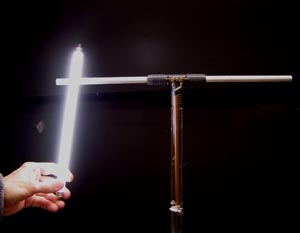

(2) The radio wave receiver is astonishingly simple — 48-cm-long copper pipe serves as a λ/2 dipole receiving antenna. Simply hold it in the middle with one hand. While standing a couple of feet from the transmitting antenna, hold a 6-inch long, 4-Watt, fluorescent lamp in the other hand and touch either end of the copper pipe with it. It will light up! (The voltage standing wave set up in the copper pipe is of sufficient voltage to light the lamp.) Slide the lamp along the length on the receiving antenna to show a voltage node in the center (the lamp goes out) and anti-nodes at the two ends — there is a voltage standing wave along the length of the receiving antenna at resonance.
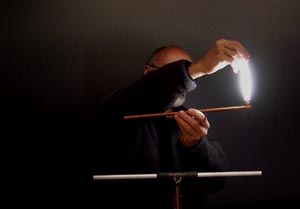
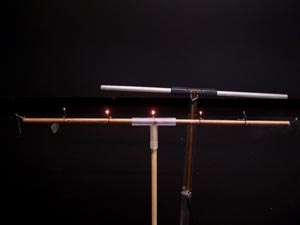
Now try the 48-cm-long copper pipe antenna which has been split into six equal-length segments. The segments are mechanically supported by a plastic rod and electrically connected to each other via miniature incandescent lamps. Hold the pipe a couple of feet from the transmitting antenna and notice the intensity variation in the lamps — brightest in the middle of the dipole, tapering off to zero at the ends. The brightness of the lamp is a qualitative indicator of the current passing through it and thus one can see, at a glance, the current variation in the receiving dipole antenna — there is a current standing wave along the length of the receiving antenna at resonance, and it is 90˚ out of phase with the voltage standing wave.
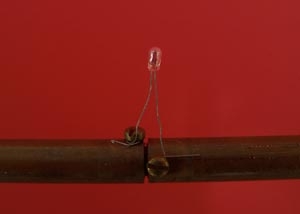
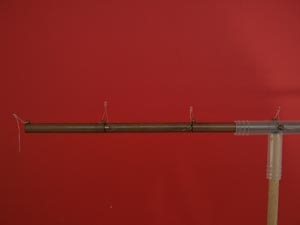
Having demonstrated that the current is maximum in the middle of the dipole, you can now switch to a copper pipe antenna that is split into two equal-length segments, with one incandescent light bulb connecting the two. Since all the power is being dissipated in a single bulb, it will be significantly brighter than the seven bulbs in the six-segment antenna. Use this antenna as your detector for demonstrations (3) through (6).
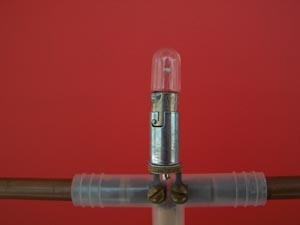
(5) The "polarizing filter" consists of five copper rods supported by a 1-meter square wooden frame. The spacing between the rods is about (0.4)λ. This "filter" is placed between the transmitting and receiving antennas. When the rods are parallel to the transmitting antenna (i.e., E-field), the field does work in moving electrons along the length of the rods and reduces the energy in the field. This is depicted in the figure. Consequently, if the receiving antenna is also parallel to the rods, very little energy reaches it and the bulb does not light. When the rods are perpendicular to the transmitting antenna, the light bulb on the receiving antenna shows no appreciable diminuation in power received.
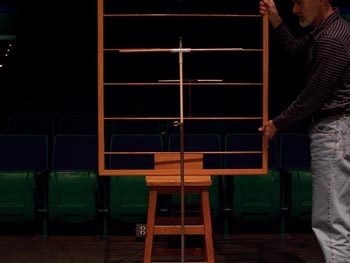
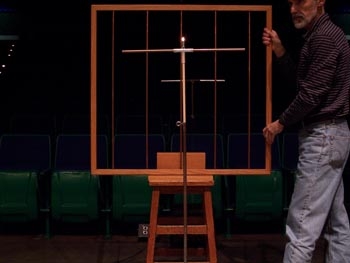
The filter can be rotated so that it is 45˚ w.r.t. the transmitting antenna. The receiving antenna light bulb will dim, but stay lit. If the receiving antenna is now also rotated 45˚, so that it is perpendicular to the rods, the intensity of the light increases again, notwithstanding that the receiving antenna is now tilted 45˚ w.r.t. the transmitting antenna. This is a nice analog of rotating the plane of polarization of light with polarizing filters.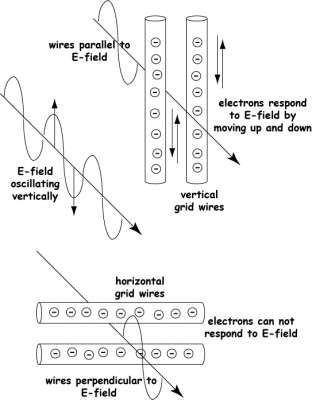
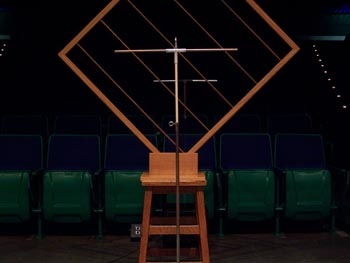
(6) Allow the electromagnetic waves from the transmitting antenna to reflect off the blackboard (which has a steel backing) or some other convenient metal surface — there will be interference between the incident and reflected wave resulting in a standing wave. By holding the receiving antenna near the reflecting surface (where the intensities of the incident and reflected wave are approximately equal), the maxima and minima of the standing wave pattern are easily shown. The distance between maxima is λ/2 = 50 cm.The demonstration of standing waves can be made even more interesting by employing a second receiving antenna which responds to the intensity of the magnetic field. This antenna is a resonant loop antenna. First, the polarization of the B-field can be demonstrated — the bulb brightness is maximum when the loop normal is parallel to B; it is zero when the normal is either along E or the propagation direction. It's most dramatic if the electric and magnetic detectors are used simultaneously. When this double probe is moved through the standing wave pattern in front of the reflecting surface, the brightness of the electric and magnetic detector bulbs peak at interleaving positions. This helps to impress on the student that there are really two different fields here. Peter Heller (Brandeis University) first demonstrated this to us at a NECUSE meeting (April 1994) and some of the insights he shared with us at the time are included in Appendix iii below.

The B-field antenna consists of a 2.75" diameter single loop formed from copper tubing. Two small copper tabs form the capacitor. It's resonance frequency is fine-tuned by inserting a dielectric (plastic ruler) between the capacitor plates.
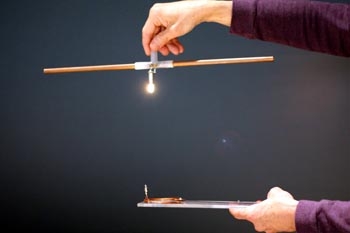
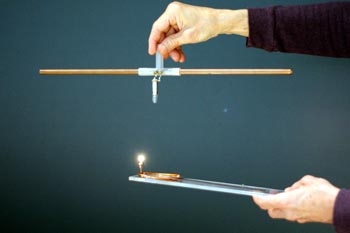
(7) Resonance: the length of the receiving dipole antenna can be changed to "de-tune" it, and be less effective. To that end, use the standard VHF "rabbit ears" antenna used on televisions. When the telescoping sections are pulled out, the length of the antenna is no longer a resonant a λ/2 dipole, and the light bulb will be noticeably dimmer.
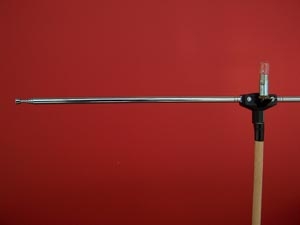
(8) The wavelength change in water can be demonstrated by using the dipole antenna inside a tank of distilled water. Submerged under water, the light bulb of the receiving antenna no longer lights. In contrast, the light bulb of a much shorter (9 cm long) dipole antenna readily lights under water, but not in the air. Since both antennas are adjusted to be λ/2, the ratio of the two antenna dipole lengths (in and out of water) is proportional to the index of refraction and the dielectric constant of water. It turns out to be equal to about 5 at this frequency. A bonus in this demonstration is the ability to show E&M standing waves in the water tank — as one moves the short dipole antenna from one end of the tank to the other, or up & down, or back & forth, the brightness of the light bulb indicates E-field intensity nodes and anti-nodes. One can explore the three dimensional standing waves in the tank!
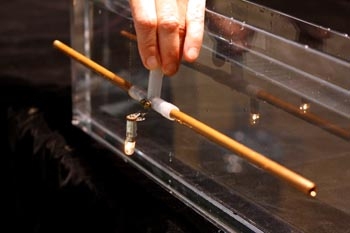
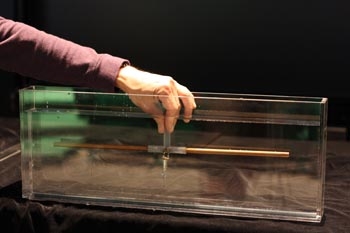
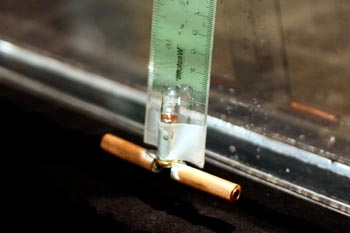
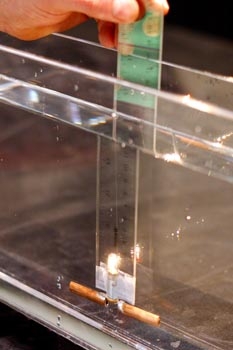
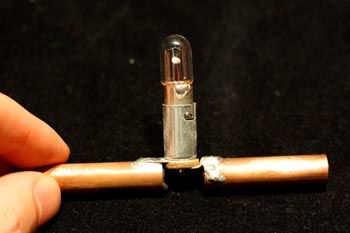
Setting it up:
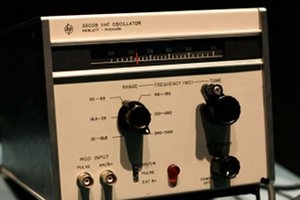
Comments:
The demonstrations provide a particularly striking accompaniment to the discussion of electromagnetic waves. A light bulb is pedagogically much more convincing as a detector than a crystal diode. After all, an electric field is "the thing that pushes electricity." That it pushes electricity through the bulb filament strongly enough to light that filament is striking to the onlooker. This is especially true in that no "return circuit" is present. (If you like, the "return" is via the "displacement current.")
Safety:
The most common criteria for human exposure to electromagnetic fields are those developed by the Institute of Electrical & Electronics Engineers (IEEE) and the National Council of Radiation Protection & Measurements (NCRP). The limit is expressed in terms of equivalent plane-wave power density and is equal to 30 W/m2. The International Commission on Non-Ionizing Radiation Protection (ICNIRP) limit is set at 22.5 W/m2. Exposure from the dipole transmitting antenna is well below these limits.
Appendix i:
With a wavelength of 1 meter, 300 MHz is right on the border between VHF and UHF. The actual length of a λ/2 dipole antenna is not exactly equal to the half-wave in space, but needs to be corrected for the thickness of the conductor in relation to the wavelength. Since the transmitting antenna is fabricated from 1/2-inch diameter aluminum rod, it is 0.48 m long. The recipe for the correction in length is given in The Radio Amateur's Handbook, 43rd edition (1966), page 365. An antenna with opens ends, of which the half-wave type is an example, is inherently a balanced radiator. However, since the antenna is fed at the center through a coaxial line, this balance is upset because one side of the radiator is connected to the shield while the other is connected to the inner conductor. On the side connected to the shield, a current can flow down over the outside of the coaxial line, and the fields thus set up cannot be canceled by the fields from the inner conductor because the fields inside the line cannot escape through the shielding afforded by the outer conductor. Hence these "antenna" currents flowing on the outside of the line will be responsible for unbalanced radiation. This kind of line radiation can be prevented by a device known as a balun (a contraction for "balanced to unbalanced"). Our antenna employs one type of balun called a bazooka, which uses a sleeve over the transmission line to form, with the outside of the outer line conductor, a shorted quarter-wave line section (see pages 387-388). The impedance looking into the open end of such a section is very high, so that the end of the outer conductor of the coaxial line is effectively insulated from the part of the line below the sleeve. The length is an electrical quarter wave, and may be physically shorter if the insulation between the sleeve and the line is other than air (which it is in our case).
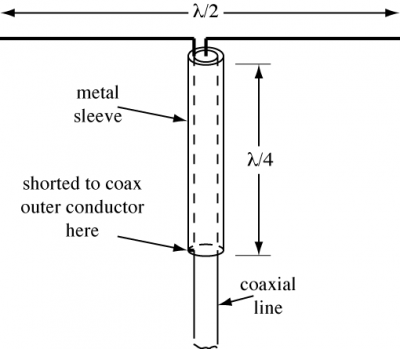
Appendix ii:
The miniature incandescent lamps are type 6833, rated at 5.0V and 60mA (0.3W). They are sometimes referred to as "grain of wheat" bulbs and have "pigtail" leads. For the single-lamp dipole antenna we use a type 47 lamp, rated at 6.3V and 150mA (1W). It has a bayonet base. If you wish to increase the distance between the receiving and transmitting antennas to more than 2 meters, a more sensitive lamp is needed — use a type 1850 lamp, rated at 5.0V and 90mA (0.5W). If using this lamp, don't come too close to the transmitting antenna as the lamp will burn out!
Appendix iii:
The B-field antenna consists of a 2.75" diameter single loop formed from 1/8" OD copper tubing. Its inductance was calculated to be 0.14μH [F. Grover, Inductance Calculations, (D. Van Nostrand, 1946) in Cabot QC 638 G78 and F.E. Terman, Radio Engineer's Handbook, (McGraw-Hill, 1950) Cabot TK 6550.T4 are two excellent references for this]. Two small copper tabs form the capacitor. They measure 2 cm square and are separated by 3 to 4 mm. The capacitance is approximately 2 pF. A thin plastic ruler between the plates serves as the dielectric — its position can be changed to adjust the capacitance. In this way the resonance frequency can be fine-tuned to match the transmitted signal. A type 338 (2.7V, 60mA) miniature incandescent lamb gives a visual indication of the field strength. The adjustment of the spacing between the lamp's two lead contact points provides the needed impedance matching. With the impedance properly matched, the bulb brilliance for this "magnetic antenna" is equal to that of the λ/2 dipole antenna. Peter Heller's thoughts on this last statement: That this is true, despite the fact that the magnetic "loop" is only a tiny fraction of a wavelength in linear extent, beautifully demonstrates the truth of the "antenna theorem": the absorption cross section of a resonant loop depends on its directivity pattern, and is of the order of the square of the wavelength, rather than the square of the linear dimensions, as one might have thought. At the level of an intermediate course in electromagnetism, the fact that the resonant loop has an effective cross section many times as great (e.g. a hundred) as the square of its size, can be discussed by showing how the energy (Poynting) flux is "funneled" into the loop. This is due to the way the incident field combines with that of the loop itself; the point here is that the loop, although it is functioning as a "receiving antenna," is also producing its own radiation field. This field is superimposed on the original incident (plane-wave) field. The Poynting vector field corresponding to the total field has the property that its "field lines" in a region of area of the order of the squared wavelength ultimately terminate (i.e. "flow to") the receiving loop, even though the latter is physically very much smaller than the wavelength. He published this in the Am. J. Phys. 65(1), pp 22-25, 1997.